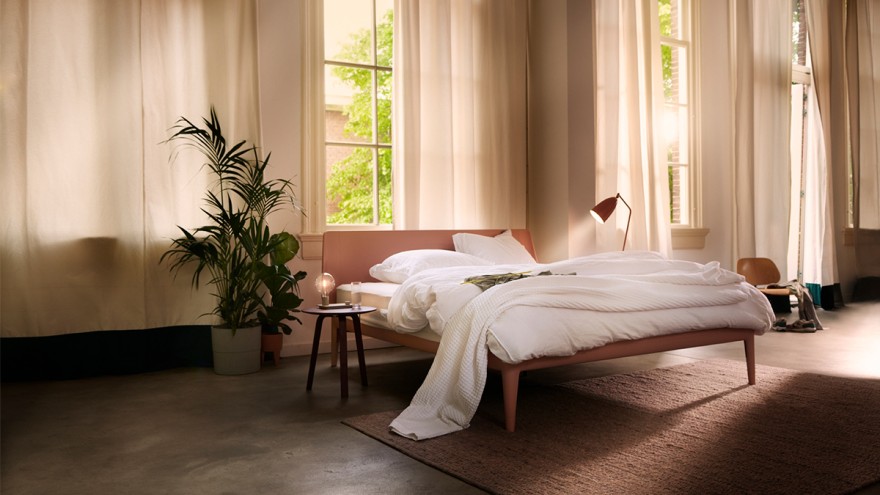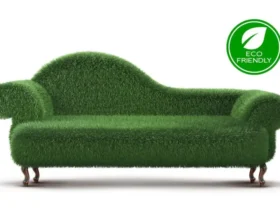A wardrobe that does not survive two home moves. A bed for which no clear information is provided on how the wood is treated. Many consumers have been in this situation and would like to buy more sustainable furniture. Find out here what this means for the industry and learn about the examples from the world of interior design that demonstrate that environmentally conscious home interiors can take many creative forms.
The Dutch manufacturer Auping presents “Essential” (design: Köhler & Wilms), the world’s first completely recyclable bed. Photo: Auping
A business field with tremendous potential
Demand for furniture with a better environmental life cycle assessment has been growing for years. More recent figures show that the trend is unabated: According to a study by PricewaterhouseCoopers (PwC), sustainability is a crucial factor for three-quarters of consumers when they are buying furniture. This makes “green” furniture attractive to manufacturers and furniture retailers not just from an ideological perspective, but also from a commercial one.
What makes furniture sustainable?
Similar to the food and drink sector, a variety of criteria play a role when it comes to the sustainability of furniture. They emerge primarily from the distinction between sustainable choices and conventional – and often inexpensive – production coupled with cost- and trend-conscious consumption.
- Renewable raw materials: Here wood still takes first place. But bamboo, cotton and new materials like algae are also renewable resources. Furniture made from recycled materials such as PET bottles or old wood fibres is a further alternative.
- Free from harmful substances: A bed that may emit harmful chemicals is out of the question for many consumers now. In addition to the main materials, the paint, glaze and other coatings should not raise any health concerns.
- Durability: A high-quality piece of furniture with a timeless design can be used for many years and handed down to the next generation. Upcycling also increases the life span of an item of furniture.
- Fair production: Sustainability also entails social responsibility. This means that good working conditions and fair wages are important considerations when it comes to buying furniture with a clean conscience.
- Short transport routes: Using regional raw materials and suppliers, combined with keeping production local, significantly improves the carbon footprint of an item of furniture.
And by the way, natural wood furniture not only dispenses with harmful substances – it even has a positive effect on the indoor climate. Find out more in our article on sustainable office furniture.
Vitra relies on cork as a renewable raw material for its “Cork Family” collection. Photo: Vitra
Labels are good – transparency is even better
The sheer diversity of different criteria often makes it difficult for consumers to tell how “green” an item of furniture is. Various labels provide some initial guidance. Here we present three of them:
- FSC® stands for wood from responsibly managed forests.
- The Blue Angel (Der Blaue Engel) is perhaps the best-known eco-label in Germany and takes the complete life cycle of a product into account.
- The DGM label awarded by the Deutsche Gütegemeinschaft Möbel e.V. (German Furniture Quality Assurance Association) is based on the product’s carbon footprint and factors in both direct and indirect emissions.
However, for many furniture retailers, the motto may well be “A label doesn’t make a buyer.” And with good reason: A survey by the market research institute Dr. Grieger & Cie. revealed that 80 per cent of respondents do not trust the information provided on sustainable furniture. This could be due to bad experiences in other sectors, such as the scandals in Germany concerning the fraudulent sale of conventional eggs as free-range or organic. But in any case, it is a clear signal that consumers’ trust can be won back only by making sustainability criteria as transparent as possible.
Example 1: FALK chair by Houe

Photo: Houe, Design: Thomas Pederse
Example 2: Modular sofa by Bolia

Photo: Bolia. Design: Glismand & Rüdiger.
Using honest and sustainable materials in its products is the guiding principle for Danish manufacturer Bolia. The new Recover modular sofa is made exclusively from recycled and recyclable materials such as surplus foam from local manufacturers. The sofa’s covers are removable, which extends its life considerably. Underneath the foam filling is a frame made from FSC-certified wood.
Original Article by: imm-cologne










